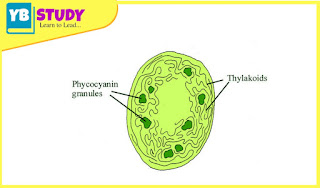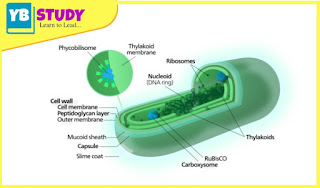Cyanobacteria : Definition, Structure, Appearance, Importance, FAQs
Cyanobacteria: Definition, Structure, Appearance, Importance
Cyanobacteria (Gk. Cyano = blue, bacterium = rod) or blue-green algae are Gram-negative photosynthetic prokaryotes, which are the most primitive organisms that are photosynthetically active. They are the most successful and self-sustaining organisms on earth and survived successfully for more than three billion years. They added oxygen to the atmosphere, which is essential for the existence of aerobic forms of living organisms.
Definition of Cyanobacteria
Cyanobacteria are a group of microscopic organisms that can carry out photosynthesis. Cyanobacteria are also known as cyanophytes They are a type of gram-negative bacteria that contain chlorophyll and are present in fresh, salty, brackish waters and estuaries. They can produce a series of dangerous toxins for humans and for this reason, they are considered as health problem that is on the rise for humans.
The appearance of cyanobacteria :
They occur mainly in freshwater forms, few are in the sea. Some species grow in hot water sources having a temperature range of 70° C to 75° C (Phormidium) and others grow at very low temperatures in the polar regions (Nostoc, Schizothrix, etc.). The Red Sea is named because of the abundant appearance of one cyanobacterium, erythronium, which gives the water a red color. They occur in a symbiotic relationship with almost every group of eukaryotes.
Characteristics of cyanobacteria
Among its main features are the following:
- They can perform photosynthesis.
- They were formerly known as blue-green algae, cyanophilic, or cyanophyte.
- They can live in different types of temperatures.
- They can produce several toxins in drinking water and seas that cause disease.
- They can cause several diseases that damage vital organs such as the liver and also cause abdominal pain, vomiting, and diarrhea.
- Depending on the type of cyanobacteria, they can damage the central nervous system causing paralysis, cardiac arrest, and death.
- They promote the development of cancer and degenerative diseases.
- They reproduce asexually but also have some unique reproduction mechanisms such as binary fission, multiple fission, and hatching.
Structural Organization of Cyanobacteria
They can be monocytes and multi-cells. The star can be a colonial or nematode. Monocyte forms can be spherical or oval. The filamentous form consists of one or more cell clones, called hair cells, surrounded by a mucous sheath. A filament may contain one (e.g. Oscillatoria) in many capillaries (e.g. Schizothrix). Cyanobacteria are characterized by the absence of a whip even in kinetic forms, although most of them are kinetic.
The cell structure of Cyanobacteria
- The cell structure of cyanobacteria is essentially similar to that of bacteria. The cell lacks a well-defined nucleus and the chromatin material is centrally located, resembling a bacterial chromosome. Like bacteria>, small circular pieces of DNA can also appear in addition to the nucleoid. They are known as plasmids or transducers.
- The cell wall is always covered by a mucosal sheath, consisting largely of the mucosal peptide.
- The cellular protoplast often differentiates into external colored chromoplasts and internal colorless cytoplasm.
- There is a coiled membrane plasma growth called a lamellar body.
- The protoplast does not have an organic membrane and contains 70S ribosomes.
- The vacuum gaps found in bacterial cells are absent. Instead, the cell may contain a vacuum filled with gas that helps regulate the body’s buoyancy in the water.
- The hallmark of a cyanobacterial cell is the presence of a system of photosynthetic plates called follicles, which make the structure more complex compared to that of bacteria. The characteristic photosynthetic pigments present in follicles are chlorophyll α and phycobilins, i.e., phycocyanin (blue), allophycocyanin (blue), and phycoerythrin (red).
- Sometimes the same species, when grown at different light wavelengths, shows changes in pigment composition. In this way, algae are believed to be able to absorb the maximum amount of light available for photosynthesis. This ability to change color with a complementary effect to light is known as the Gaidukov effect or complementary color adjustment. e.g. Trichodesmium erythema causes red Sea.
- The cell contains reserve food material in the form of a special starch called cyanophycean starch. Other granules present in a cyanobacterial cell are volts granules and polyhedral bodies.
Metabolism of Cynobacteria
They are the most self-sustaining organisms because most of them can convert atmospheric nitrogen into ammonium compounds in addition to using atmospheric CO, to synthesize organic food during photosynthesis. Nitrogen stabilization under anaerobic conditions occurs mainly in specialized cells called heterocysts. Heterocysts are large, pale mucous membranes without dense cell walls that are impermeable to oxygen.
Reproduction of Cyanobacteria
Cyanobacteria reproduce plants and asexually. Sexual reproduction is usually absent. However, gene recombination is reported. Cyanobacteria multiply on
- Binary cleavage: Appears in single-celled forms. The daughter cells are formed by amitotic division, they separate immediately after division.
- Fragmentation: Appears in nematode forms. The yarn splits into small pieces or fragments that grow to form new yarns.
- Hormones: They are small sections of hair that are separated from the parent due to the death of interfering cells (decides).
Function of cyanobacteria
- Cyanobacteria have the function of participating in about 30% of the photosynthesis that occurs on the planet every day and is also an important part of the composition of the atmosphere.
- They play an important role in the proper development of plant life, to better understand it, we can say that the chloroplast that is inside a plant cell and that produces its food is a cyanobacterium.
- Having the ability to process nitrogen from the atmosphere and then convert it to organic form, this process is extremely important for many plants to grow properly.
- They fix nitrogen in the soil, coral reefs, and different water environments, making nitrogen available to many types of ecosystems.
Importance of cyanobacteria
- They play an important role in the evolution of the aerobic spirits of life.
- They convert atmospheric nitrogen into ammonium compounds and the excess of these compounds is secreted enriching the soil.
- Cyanobacteria such as Nostoc and Anabaena have been used to reclaim soils.
- They benefit the partner by providing nitrogenous compounds due to their ability to fix nitrogen.
- Some blue bacteria such as Nostoc serve as food
- Lyngby extract is a cyanobacterium used to treat antibiotics.
- Some blue bacteria such as Microcystis aeruginosa, Anabaena, and Aphanizomenon flos-aquae secrete toxins in the surrounding area, which harm aquatic animals and even human beings.
Frequently Asked Questions (FAQs) on Cyanobacteria
1. Why are cyanobacteria important?
Answer: Cyanobacteria are very important organisms for the health and growth of many plants. It is one of the few groups of organisms that can convert inert atmospheric nitrogen into an organic form, such as nitrates or ammonia.
2. What do cyanobacteria do to humans?
Answer: Cyanotoxins can cause gastrointestinal, nervous, hepatic, or dermal toxicity. The signs and symptoms reported after exposure also vary depending on the route of exposure. Ingestion: Gastrointestinal (GI) effects include nausea, vomiting, diarrhea, and mild liver enzymes.
3. Where cyanobacteria are found?
Answer: Cyanobacteria are found in almost every terrestrial and aquatic habitat – oceans, freshwater, wet soil, temporarily wet rocks in deserts, bare rocks, and soil, and even rocks in Antarctica. They can appear as planktonic cells or form phototrophic biofilms.
4. Are cyanobacteria bacteria or algae?
Answer: These are also referred to as blue-green algae. Although they are capable of conducting oxygen-producing photosynthesis and living in many of the same environments as eukaryotic algae, cyanobacteria are gram-negative and therefore prokaryotic.
5. Cyanobacteria Good or Bad?
Answer: Cyanobacteria can help by providing nutrients to plants such as rice and beans. However, cyanobacterial blooms can also be dangerous. Harmful cyanobacterial algal blooms – known as HABs or CyanoHABs – can consume oxygen in the water and block out the sunlight that freshwater plants and animals must survive.
6. Can cyanobacteria kill you?
Answer: Blooming cyanobacteria can produce cyanotoxins in such concentrations that they poison and even kill animals and humans. … Among the cyanotoxins are some of the most powerful natural poisons known, including poisons that can cause rapid death from respiratory failure.
7. What is an example of cyanobacteria?
Answer: Nostocales
Chroococcales
Oscillators
Prochlorophytes
Synechococcales
8. Are Cyanobacteria Harmful to Humans?
Answer: Cyanobacteria, or blue-green algae, are found worldwide in calm waters rich in nutrients. Some species of cyanobacteria produce toxins that infect animals and humans. People can be exposed to cyanobacterial toxins by drinking or swimming in contaminated water.
9. Can you see cyanobacteria?
Answer: You may or may not see cyanobacterial blooms. Sometimes they stay below the surface of the water, sometimes they float on the surface. The flowers can be blue, bright green, brown, or red. The blooms sometimes look like a color floating on the surface of the water.
10. What are blue-green algae?
Answer: Although often referred to as algae, blue-green algae are not algae at all, but types of bacteria called cyanobacteria.
11. Can cyanobacteria fix nitrogen?
Answer: Cyanobacteria are oxygen-photosynthetic bacteria that are widespread in marine, freshwater, and terrestrial environments, and many of them are capable of securing atmospheric nitrogen. This strategy is known as spatial separation of oxygen photosynthesis and nitrogen fixation.
12. Do blue-green algae have chlorophyll?
Answer: Blue-green algae (cyanobacteria) are a group of prokaryotic, autotrophic microorganisms that contain photosynthetic pigments (chlorophyll and phycocyanin).
13. What is the difference between Rhizobium and cyanobacteria in the way nitrogen is attached to the soil?
Answer: Most rhizomes have well-preserved oozing genes that encode signals, and ozonating agents, that are perceived by the plant. Plant cyanobacterial symbiosis is diverse, but mainly involves a microbial genus, Nostoc.
14. How Cyanobacteria reproduce
Answer: Cyanobacteria reproduce asexually, either by binary or multiple cleavages into single-celled and colonial forms or by fragmentation and spore formation in nematode species. Under favorable conditions, cyanobacteria can reproduce at an explosive rate, forming dense concentrations called flowers.
15. Can cyanobacteria reproduce sexually?
Answer: Cyanobacteria reproduce through cell division, while some nematode species produce specialized plant fragments called hormones. There is also evidence of sexual reproduction (mating) and genetic recombination.
16. What is the function of cyanobacteria?
Answer: Cyanobacteria are important in the nitrogen cycle.
Cyanobacteria are very important organisms for the health and growth of many plants.
It is one of the few groups of organisms that can convert inert atmospheric nitrogen into an organic form, such as nitrates or ammonia.


